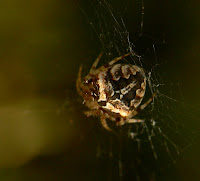
Class: Arachnida
Order: Araneae
Suborder: Araneomorphae
Family: Araneidae
Genus: Araneus
Esta araña se caracteriza por los tubérculos angulosos de su abdomen que presenta también marcas blancas asimétricas sobre el centro.Su área de distribución comprende desde el Mediterráneo hasta Europa Central.Tejen grandes redes circulares entre los arbustos y los árboles, y en muchas ocasiones, algunas líneas de soporte tocan el suelo. De esta manera, la araña puede sentir las vibraciones que producen los animales grandes sobre el suelo, y se esconden rápidamente en una esquina de su red.Se alimentan de insectos, en especial de dípteros, que no pueden percibir la tela de la araña hasta que su proximidad les impide cualquier maniobra para evitarla.
Genus Araneus
Araneus is probably one of the most spotted spiders because of their size, which varies between 8 and 20 mm, and their large webs. Especially during autumn these spiders become large and you may walk in their webs they construct during the morning. Also in the morning their webs are seen when the sun illuminates them, often full with dewdrops.The courtship can be hazardous for the small male. The female makes her yellowish cocoon with 300 - 800 eggs in autumn and she dies. The eggs will hatch in May. The young spiders are yellow with are dark patch on the abdomen.
If the web is damaged by wind and rain or by the large amount of caught prey, it is eaten by the spider to conserve protein. Only the foundation lines are left and new radii and capturing spirals are constructed. Some of the orb weavers use their web for longer periods and replace only part, usually one half, of their web at one time.The species varies a lot in color and markings.




It is very similar to Araneus diadematus but can be distingushed by the angular tubercles on the abdomen and the often asymetrical white markings at the center of the abdomen.The large orb web is often found on bushes and trees and often has support lines touching the ground. As a result the spider can feel the vibrations of a human walking past and will often immediatley retreat to a safe corner of its web. The web is often built in a place commonly used by many flying insects, between two trees often provides a good source of insects.It displays behaviour very similar to Araneus diadematus except that its web has no retreat so the spider sits at the center of the web.
Cartagena.2006/07


1 comentario:
es una de las arañas mas facil de encontrar pero la mas complicado de pillar por esa red tan intensa que tiene. No se cuantas fotos he podido tirar de ella, pero hasta hoy ninguna mias me ha satisfecho como las tuyas. Felicidades Joaquin.
Publicar un comentario